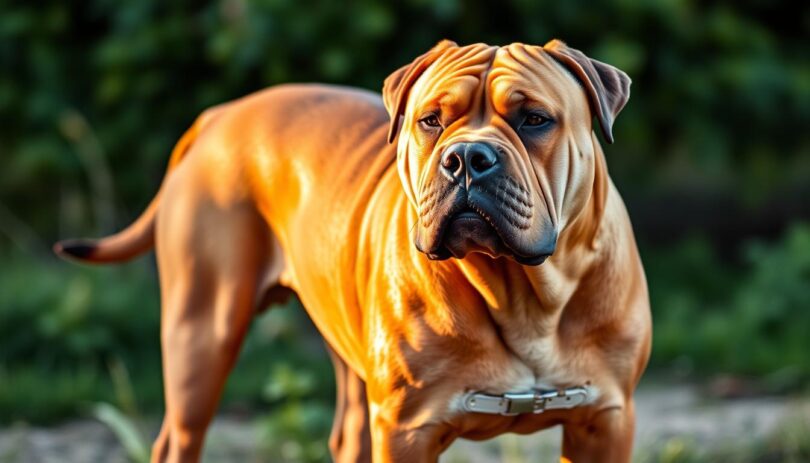Did you know over 60% of designer dog owners report choosing their pets for unique personality traits inherited from parent breeds? This trend shines a light on crossbreeds like the Pit Pei, a striking blend of the Chinese Shar Pei and American Pitbull Terrier. With their wrinkled coats and muscular builds, these hybrids capture attention—but their appeal goes far beyond looks.
This crossbreed combines two iconic lineages. The Shar Pei brings ancient guardian instincts, while the Pitbull contributes loyalty and energy. The result? A companion with distinctive physical features and a temperament balancing independence with affection.
Our guide dives into everything potential owners should consider. You’ll discover:
- Key traits shaped by genetics
- Health considerations for wrinkle-prone skin
- Training strategies for strong-willed personalities
We’ve compiled insights from veterinarians and experienced owners to help you navigate this breed’s specific needs. Whether you’re researching or ready to adopt, you’ll find actionable tips for creating a thriving environment. Let’s explore what makes this hybrid both challenging and deeply rewarding.
Getting to Know shar pei and pitbull mix dogs
What happens when a guardian breed meets a loyal companion? This crossbreed blends the Shar Pei’s protective instincts with the Pitbull Terrier’s playful energy. Their physical features often showcase a muscular frame paired with signature folds—a living testament to their diverse lineage.
Overview and Key Characteristics
The Chinese parent contributes loose skin and a distinctive muzzle, while the American counterpart adds athleticism. Coat textures vary from smooth to coarse, often in shades like fawn or brindle. Many inherit the Pitbull’s expressive eyes, framed by the Shar Pei’s trademark wrinkles.
What Makes This Mix Unique
These hybrids balance independence with devotion—a rare combination. While they form strong bonds with families, their alertness makes them natural watchdogs. Early socialization helps channel their intelligence positively, as highlighted in this guide to mixed breed behavior.
Unlike many designer dogs, this cross often displays pronounced loyalty without excessive clinginess. Their adaptability shines in active households, though they require consistent training. Grooming needs focus on skin folds to prevent irritation—a small trade-off for such a distinctive companion.
Breed History and Origins
Behind every unique crossbreed lies a tapestry of ancestral stories. The parent breeds of this hybrid carry legacies spanning continents and centuries, shaping their modern characteristics through survival, cultural shifts, and human intervention.
The Chinese Shar Pei Legacy
Originating in southern China over 2,000 years ago, these guardians served as multipurpose farm dogs. Historical records show their roles ranged from hunting to protection. By the 1970s, political turmoil nearly erased the breed—fewer than 100 remained worldwide. Dedicated enthusiasts revived the lineage using dogs from Hong Kong and Taiwan, preserving their signature wrinkles and stoic demeanor.
The Heritage of the American Pitbull Terrier
Descended from 19th-century English bull-baiting dogs, early Pitbull Terriers crossed the Atlantic with immigrants. Breeders refined them for loyalty and resilience, transitioning from controversial pasts to beloved family companions. Modern Pitbull-type dogs often work in therapy and service roles, showcasing their adaptability.
Breeding practices for both lineages evolved through necessity. War nearly destroyed one breed while societal changes reshaped the other’s purpose. Today’s intentional crossbreeding combines these survival stories, aiming to merge protective instincts with trainable temperaments—a testament to canine resilience across generations.
Distinctive Physical Appearance and Coat Features
Imagine a canine canvas where ancient guardian lineage meets modern athleticism. This crossbreed’s physique tells a story through every fold and muscle, blending ancestral traits into a living masterpiece. Two elements dominate their appearance: textured skin patterns and a coat that defies predictability.
Signature Wrinkles and Muzzle
Forehead creases cascade into a muzzle resembling crumpled velvet—a hallmark inherited from their wrinkled ancestor. These folds soften as the dog matures, though many retain pronounced facial pleats into adulthood. Proper care prevents moisture buildup in skin folds, a practice detailed in our guide to caring for wrinkly breeds.
Coat Colors and Texture Variations
The coat spectrum spans from the Pitbull Terrier’s glossy short hair to the Shar Pei’s bristly horsecoat. Common hues include cinnamon brindle, slate blue, and cream with black masks. Some develop unique patterns as they age—a fawn puppy might sport charcoal tipping by maturity.
Muscle definition from the Pitbull lineage creates a sculpted silhouette beneath loose skin. Texture variations often correlate with color: red coats tend toward coarseness, while white patches feel silkier. These physical markers help identify the crossbreed, though each dog’s combination remains delightfully unpredictable.
Temperament and Behavioral Traits
Owning a hybrid often feels like decoding a genetic puzzle. This crossbreed’s personality reveals itself through surprising contradictions—fierce loyalty paired with self-reliance, playful bursts balanced by calm observation. Their behavior reflects centuries of selective breeding in both parent lines.
Loyalty, Independence, and Social Nature
Reddit users describe these companions as “shadows with opinions.” One owner shared: “Mine follows me everywhere but ignores commands when she’s focused on something.” This duality stems from the Pitbull Terrier’s devotion clashing with the Shar Pei’s stubborn streak.
Positive reinforcement training works best. Reward calm behavior with treats or praise to reinforce desired traits. Early socialization helps manage their protective instincts—introduce them to various people and pets during puppyhood.
Family Compatibility and Interaction with Children
Families report strong bonds forming quickly. These dogs often become “velcro pets,” sticking close to loved ones. Their patience with children shines during playtime, though supervision is advised due to their high energy levels.
Create clear routines to channel their enthusiasm. Morning walks and puzzle toys prevent boredom-induced mischief. Many thrive in homes with yards but adapt to apartments if given adequate exercise.
Remember: consistency shapes temperament. Structured training and affection help this intelligent dog become a well-rounded family member. Their blend of spiritedness and serenity makes every day an adventure.
Health Considerations and Common Issues
Nearly 40% of crossbreed owners report skin-related vet visits within their pet’s first year. Genetic traits from both parent breeds create unique health profiles requiring proactive care. Understanding these risks helps owners make informed decisions and improve their companion’s quality of life.
Skin Conditions and Infections
Those signature wrinkles demand daily attention. Deep skin folds trap moisture, creating ideal environments for bacterial or yeast infections. Studies show 1 in 3 dogs with excessive skin folds develop dermatitis without proper cleaning routines.
Watch for redness, odor, or excessive scratching—early signs of trouble. Use vet-approved wipes between folds and keep the coat dry. Allergies from food or environmental factors often worsen skin conditions, requiring specialized diets.
Joint Challenges and Dysplasia Concerns
Orthopedic issues affect 20% of medium-sized crossbreeds. Hip and elbow dysplasia—joint malformations causing pain—appear most frequently. The Orthopedic Foundation for Animals reports 18.7% of mixed breeds show early signs of joint degeneration.
Maintain lean body weight through portion control and low-impact exercise. Glucosamine supplements support cartilage health, while ramps reduce stair-related strain. Sudden reluctance to jump or climb signals potential joint problems needing veterinary assessment.
Regular check-ups catch issues before they escalate. Bloodwork and X-rays during annual exams provide baselines for tracking health changes. With proper prevention and swift treatment, many genetic conditions become manageable rather than debilitating.
Diet, Nutrition, and Recommended Dog Food Options
Proper nutrition acts as the foundation for a thriving companion. This hybrid’s unique needs—from wrinkle care to joint support—demand meals that address multiple health priorities. Let’s explore how to fuel their vitality through smart food choices and targeted supplements.
Choosing the Right Dog Food for Optimal Health
High-quality formulas prioritize whole proteins like chicken or salmon. The Farmer’s Dog offers fresh-frozen meals with pre-portioned servings, ideal for managing weight. Their customized plans currently provide 50% off first orders—a budget-friendly way to test recipes.
Sundays Food For Dogs uses air-dried ingredients to preserve nutrients. This method balances convenience with dental benefits, as the crunchy texture reduces plaque. For raw enthusiasts, We Feed Raw delivers frozen patties rich in omega fatty acids to promote glossy coats.
Supplementation to Support Joints and Skin
Add fish oil or coconut oil to meals for skin hydration. Zesty Paws Allergy Immune Bites help combat irritation between folds. For joints, VetriScience GlycoFlex chews provide glucosamine and MSM to cushion active bodies.
Measure portions using a kitchen scale—overfeeding strains joints. Split daily food into three smaller meals to maintain energy levels. Freeze-dried liver treats work well for training without excess calories.
Remember: Every dog’s needs differ. Consult your vet to tailor diets for allergies or sensitivities. With the right balance of premium food and supplements, you’ll nurture resilience in your companion for years to come.
Exercise, Training, and Socialization Essentials
What separates a content companion from a restless troublemaker? The answer lies in balancing physical exertion with brain games. These hybrids thrive when their sharp minds and athletic bodies get daily challenges. A structured routine prevents boredom while strengthening your bond.
Daily Activity and Mental Stimulation
Start mornings with a 30-minute walk or backyard fetch session. Instagram trainers like @CanineEnthusiast recommend rotating activities: try flirt poles for agility practice one day, scent trails the next. Afternoons call for puzzle toys stuffed with kibble—the Outward Hound Nina Ottosson series keeps paws busy for hours.
Evening playdates with calm dogs teach social skills. One Reddit user shared: “We do ‘pack walks’ with neighbors’ pets twice weekly—it curbs his territorial streak.” Always watch for signs of overexertion, like heavy panting or lagging behind.
Positive Reinforcement-Based Training Tips
Use high-value treats like freeze-dried liver during drills. Train in short bursts (5-7 minutes) to match their attention span. When teaching “leave it,” toss a toy instead of food to redirect energy positively.
Create a “Find It” game by hiding treats under cups. Praise correct choices enthusiastically—their intelligence loves problem-solving. Consistency matters: use the same commands (“drop,” not “release”) across all family members.
Weekend hikes or swimming sessions burn excess energy while building trust. Remember: tired muscles and engaged minds make for a happy, well-adjusted companion.
Grooming and Maintenance Guidelines
Ever wonder how to keep those signature folds clean and healthy? Proper care prevents common issues while enhancing your companion’s comfort. Regular grooming routines become bonding moments that strengthen trust and monitor wellness.
Wrinkle Cleaning and Coat Care
Start with daily wrinkle inspections. Use a soft, damp cloth to gently wipe between folds—pat dry thoroughly to prevent moisture buildup. Veterinarians recommend hypoallergenic wipes for sensitive skin, especially around facial creases.
Brush the short coat weekly with a rubber curry tool. This removes loose hair and distributes natural oils. For stubborn dirt, bathe monthly using oatmeal shampoo to avoid irritation.
Nail, Ear, and Dental Hygiene
Trim nails every 3-4 weeks to prevent cracking. If you hear clicking on floors, it’s time for a trim. Check ears weekly for debris—clean with vet-approved solution on cotton pads, never inserting tools into the ear canal.
Brush teeth 3x weekly with enzymatic toothpaste. Dental chews help reduce plaque between brushings. Families raising puppies should start these habits early for easier maintenance.
Create a weekly checklist:
- Monday: Wrinkle check & coat brush
- Wednesday: Ear inspection
- Saturday: Nail trim if needed
Professional groomer Lisa Marquez advises: “Consistency prevents emergencies. Ten minutes daily avoids hours at the vet later.” Your dedication directly impacts their vitality and happiness.
Key Considerations When Adopting or Buying
Choosing the right companion requires careful thought beyond just their adorable wrinkles. Ethical sourcing and health evaluations determine your future pet’s quality of life—and your peace of mind.
Evaluating Breeder or Rescue Options
Rescues often provide pre-socialized animals with known medical histories. Organizations like ASPCA report 25% of shelter dogs are purebreds or intentional crosses. Ask rescues about the dog’s experience with children, reactions to strangers, and current health conditions.
Reputable breeders allow home visits to meet parent dogs. Verify genetic testing certificates for joint and skin problems. Red flags include unwillingness to share veterinary records or multiple litters available weekly.
What to Look for in a Healthy Mix
Bright eyes and clean ears signal good health. Puppies should approach you curiously, not cower. Check for pink gums and smooth breathing during play. A dull coat or crusty skin suggests underlying issues.
Ask about the dog’s age-appropriate vaccinations and deworming schedule. Observe how they interact with littermates—proper socialization starts early. Responsible breeders prioritize temperament over appearance, ensuring balanced companions for your home.
Remember: adoption is a 10-15 year commitment. Prepare questions about exercise needs, dietary restrictions, and past behavioral challenges. Your diligence today builds a thriving partnership tomorrow.
Parting Insights on Shar Pei and Pitbull Mix Dogs
Bringing home a unique companion shaped by centuries of canine history demands thoughtful preparation. These hybrids thrive when owners embrace their dual heritage – the protective instincts of ancient guardians paired with the enthusiasm of modern working breeds. Their distinct wrinkles and athletic build tell a story of resilience, while their balanced nature offers both affection and self-reliant charm.
Prioritize regular health screenings and wrinkle maintenance to prevent common issues. Pair nutrient-rich meals with joint-supporting supplements to fuel their active lifestyle. Consistent training channels their intelligence into positive behaviors, while early socialization builds confidence around new people and pets.
Prospective owners should consult veterinarians and breed specialists before committing. Reputable sources like the American Kennel Club provide additional guidance for welcoming strong-willed breeds into your home. With proper care, these loyal companions reward families with years of laughter and steadfast devotion.
Every thoughtful choice – from diet to exercise routines – shapes your journey together. Embrace the learning process, and you’ll discover a deeply fulfilling partnership built on mutual trust and understanding.
FAQ
Are Shar Pei and Pitbull mixes good with children?
With proper socialization, these mixes often show loyalty and patience toward family members. Supervise interactions with young kids due to the breed’s independent streak and potential for high energy during play.
How often should I clean my dog’s wrinkles?
Clean skin folds 2–3 times weekly using vet-approved wipes to prevent infections. Dry thoroughly after baths or swimming to avoid moisture buildup in creases.
What joint issues are common in this mix?
Elbow and hip dysplasia occur frequently. Maintain healthy weight through portion control and consider supplements like glucosamine, especially as your dog ages.










Leave a Comment